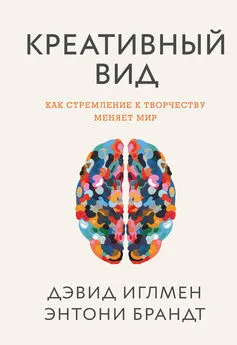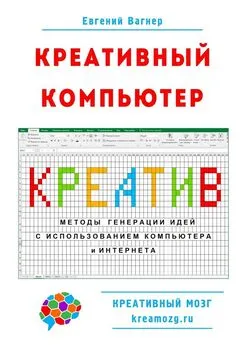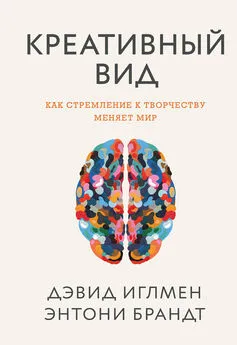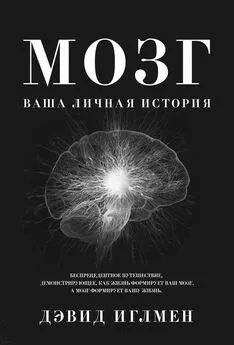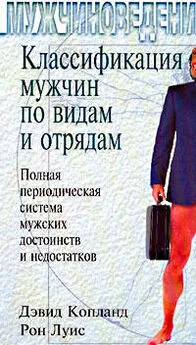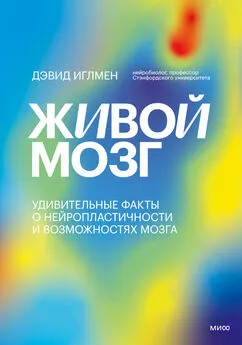Дэвид Иглмен - Креативный вид
- Название:Креативный вид
- Автор:
- Жанр:
- Издательство:Манн, Иванов и Фербер
- Год:2018
- Город:Москва
- ISBN:9785001176831
- Рейтинг:
- Избранное:Добавить в избранное
-
Отзывы:
-
Ваша оценка:
Дэвид Иглмен - Креативный вид краткое содержание
Креативный вид - читать онлайн бесплатно ознакомительный отрывок
Интервал:
Закладка:
Gordon J.E. The New Science of Strong Materials, Or, Why You Don’t Fall Through the Floor. Princeton, NJ: Princeton University Press, 1984.
Gottschall Jonathan. The Storytelling Animal: How Stories Make Us Human. New York: Mariner Books, 2012.
Gray Peter. Children’s Freedom Has Declined, So Has Their Creativity. Psychology Today. September 17, 2012. Accessed April 27, 2014, http://www.psychologytoday.com/blog/freedom-learn/201209/children-s-freedom-has-declined-so-has-their-creativity.
Greenblatt Stephen. The Norton Anthology of English Literature. Vol. B. New York: W.W. Norton, 2012.
Greene Maxine. Releasing the Imagination: Essays on Education, the Arts, and Social Change. San Francisco: Jossey-Bass Publishers, 1995.
Greene Maxine. Variations on a Blue Guitar: The Lincoln Center Institute Lectures on Aesthetic Education. New York: Teachers College Press, 2001.
Grimes Anthony, Breslauer David N., Long Maureen, Pegan Jonathan, Lee Luke P. and Khine Michelle. Shrinky-Dink Microfluidics: Rapid Generation of Deep and Rounded Patterns. Lab Chip 8, no. 1 (2008): 170–172.
Gross Daniel. Another Casualty of the Department of Energy’s Loan Program Is Making a Comeback. Slate. August 8, 2014. Accessed August 20, 2015, http://www.slate.com/articles/business/the_juice/2014/08/beacon_power_the_department_of_energy_loan_recipient_is_making_a_comeback.html.
Halevy Alon, Norvig Peter, and Pereira Fernando. The Unreasonable Effectiveness of Data. IEEE Intelligent Systems 24, no. 2 (2009): 8–12.
Hall Marcia B. Michelangelo’s Last Judgment. Cambridge, UK: Cambridge University Press, 2005.
Hall Mimi. Sci-fi writers join war on terror. USA Today. May 31, 2007. Accessed May 11, 2016, http://usatoday30.usatoday.com/tech/science/2007-05-29-deviant-thinkers-security_N.htm.
Hardus Madeleine E., Lameira Adriano R., Van Schaik Carel P. and Wich Serge A. Tool Use in Wild Orangutans Modifies Sound Production: A Functionally Deceptive Innovation? Proceedings of the Royal Society B 276 no. 1673 (2009): 3689–3694, doi: 10.1098/rspb.2009.1027, https://www.ncbi.nlm.nih.gov/pmc/articles/PMC2817314.
Hardy Quentin. The Robotics Inventors Who Are Trying to Take the ‘Hard’ Out of Hardware. New York Times. April 14, 2015.
Harnisch Larry. Burbank Time Capsule Revisited. Los Angeles Times. March 17, 2009. Accessed July 18, 2015, http://latimesblogs.latimes.com/thedailymirror/2009/03/burbank-time-ca.html.
Hathaway Ian and Litan Robert. The Other Aging of America: The Increasing Dominance of Older Firms. The Brookings Institution. July 2014. Accessed May 17, 2016, https://www.brookings.edu/research/the-other-aging-of-america-the-increasing-dominance-of-older-firms.
Hedstrom-Page Deborah. From Telegraph to Light Bulb with Thomas Edison. Nashville: B&H Publishing Group, 2007.
Hemingway Ernest, Hemingway Patrick, and Hemingway Seán A. A Farewell to Arms: The Hemingway Library Edition. New York: Scribner, 2012.
Henrich Joseph, Heine Seven J., and Norenzayan Ara. The Weirdest People in the World? Behavioral and Brain Sciences 33 (2010): 61–135, doi: 10.1017/S0140525X0999152X, http://www2.psych.ubc.ca/~henrich/pdfs/WeirdPeople.pdf.
Hickey Maud. Music outside the Lines: Ideas for Composing in K-12 Music Classrooms. Oxford: Oxford University Press, 2012.
Hilmes Michele. Hollywood and Broadcasting: From Radio to Cable. Urbana: University of Illinois Press, 1990.
Hiltzik Michael A. Dealers of Lightning: Xerox PARC and the Dawn of the Computer Age. New York: HarperCollins, 2000.
Hofstadter Douglas R., and Sander Emmanuel. Surfaces and Essences: Analogy as the Fuel and Fire of Thinking. New York: Basic Books, 2013.
Holt Rackham. George Washington Carver: An American Biography. Garden City, NY: Doubleday, 1943.
How Companies Incentivize Innovation. SIT. May 2013. Accessed May 11, 2016, http://www.innovationinpractice.com/innovation_in_practice/2013/05/how-companies-incentivize-innovation.html.
Hughes Jonnie. On the Origin of Tepees: The Evolution of Ideas (and Ourselves). New York: Free Press, 2011.
Hughes Robert. Art: Ku Klux Komix. Time. November 9, 1970. Accessed July 14, 2014, http://content.time.com/time/magazine/article/0,9171,943281,00.html.
Hughes Robert. Art: Reflections in a Bloodshot Eye. Time. August 3, 1981. Accessed July 14, 2014, http://content.time.com/time/magazine/article/0,9171,949302-2,00.html.
Ilin Andrew V., Cassady Leonard D., Glover Tim W., and Diaz Franklin R. Chang. VASIMR® Human Mission to Mars. Presentation at the Space, Propulsion and Energy Sciences International Forum, College Park, MD, March 15–17, 2011.
Illy József. The Practical Einstein: Experiments, Patents, Inventions. Baltimore: Johns Hopkins University Press, 2012.
Israel Paul. Edison: A Life of Invention. New York: John Wiley, 1998.
Jakab Peter L. and Young Rick. The Published Writings of Wilbur & Orville Wright. Washington, D.C.: Smithsonian Books, 2000.
Janson S., M. Middendorf and Beekman M. Searching for a New Home — Scouting Behavior of Honeybee Swarms. Behavioral Ecology 18, no. 2 (2006): 384–392.
Johnson George. Quantum Leaps: ‘Einstein’s Jewish Science,’ by Steven Gimbel. New York Times. August 3, 2012. Accessed May 11, 2016, http://www.nytimes.com/2012/08/05/books/review/einsteins-jewish-science-by-steven-gimbel.html?pagewanted=all&_r=1.
Johnson Steven. How We Got to Now: Six Innovations That Made the Modern World. New York: Riverhead Books, 2014.
Johnson Todd. How Composites and Carbon Fiber Are Used. About. Accessed December 28, 2014, http://composite.about.com/od/aboutcarbon/a/Boeings-787-Dreamliner.htm.
Jones Kent. Playtime. RSS. June 3, 2001. Accessed August 21, 2015, http://www.criterion.com/current/posts/115-playtime.
Jones Robert P., Cox Daniel, Dionne E. J., Jr., Galston William A., Cooper Betsy, and Lienesch Rachel. How Immigration and Concerns About Cultural Change Are Shaping the 2016 Election. Washington, D.C.: Public Religion Research Institute, 2016.
Kahn Robert S. Beethoven and the Grosse Fuge: Music, Meaning, and Beethoven’s Most Difficult Work. Lanham, MD: Scarecrow Press, 2010.
Kaplan Fred. ‘WarGames’ and Cyber Security’s Debt to a Hollywood Hack. New York Times. February 19, 2016. Accessed May 11, 2016, http://www.nytimes.com/2016/02/21/movies/wargames-and-cybersecuritys-debt-to-a-hollywood-hack.html?_r=0.
Kaplan Robert. The Nothing That Is: A Natural History of Zero. Oxford: Oxford University Press, 2000.
Kardos J.L. Critical Issues In Achieving Desirable Mechanical Properties for Short Fiber Composites. Pure and Applied Chemistry 57, no. 11 (1985): 1651–1657.
Karpman Ben. Ernest Everett Just. Phylon 4, no. 2 (1943): 159–163. Accessed May 19, 2014, http://www.jstor.org/stable/271888.
Karve Aneesh. Sixteen Techniques for Innovation (And Counting). Visual Magnetic. May 8, 2010. Accessed July 21, 2014, http://www.visualmagnetic.com/2010/05/forms-of-innovation.
Kaufman Allison B., Butt Allen E., Kaufman James C., and Colbert-White Erin M. Towards a Neurobiology of Creativity in Nonhuman Animals. Journal of Comparative Psychology 125, no. 255–272, doi: 10.1037/a0023147, https://s3.amazonaws.com/jck_articles/KaufmanButtKaufmanColbertWhite2011.pdf.
Kelley Tom. The Art of Innovation: Lessons in Creativity from IDEO, America’s Leading Design Firm. London: Profile, 2016.
Kemp Martin. Leonardo Da Vinci: Experience, Experiment and Design. Princeton: Princeton University Press, 2006.
Kennedy Pagan. Inventology: How We Dream Up Things That Change the World. New York: Houghton Mifflin Harcourt, 2016.
Kerntopf Paweł, Stanković Radomir, De Vos Alexis, and Astola Jaakko. Early Pioneers in Reversible Computation. Japan: Research Group on Multiple-Valued Logic, 2014. Accessed August 21, 2014, http://cela.ugent.be/catalog/pug01:4400338.
Keynes John Maynard. Economic Possibilities for Our Grandchildren. В сб.: Essays in Persuasion. New York: Norton, 1963.
Kim Kyung Hee. The Creativity Crisis: The Decrease in Creative Thinking Scores on the Torrance Tests of Creative Thinking. Creativity Research Journal 23, no. 4 (2011): 285–295.
Kim Sangbae, Laschi Cecilia, and Trimmer Barry. Soft Robotics: A Bioinspired Evolution in Robotics. Trends in Biotechnology 31, no. 5 (2013): 287–294.
King Jr. Martin Luther. Why We Can’t Wait. New York: Signet Classics, 2000.
Klein Maury. The Power Makers: Steam, Electricity, and the Men Who Invented Modern America. New York: Bloomsbury Press, 2008.
Klemens Guy. The Cellphone: The History and Technology of the Gadget That Changed the World. Jefferson, NC: McFarland, 2010.
Kleon Austin. Newspaper Blackout. New York: Harper Perennial, 2010.
Koch Christof. Keep it in Mind. Scientific American. May 2014. 26–29.
Koestler Arthur. The Act of Creation. New York: Macmillan, 1965.
Konnikova Maria. The Open-Office Trap. New Yorker. January 7, 2014, http://www.newyorker/business/currency/the-open-office-trap.
Kowatari Yasuyuki, Hee Lee Seung, Yamamura Hiromi, and Yamamoto Miyuki. Neural Networks Involved in Artistic Creativity. Human Brain Mapping 30 no. 5 (2009): 1678–1690, doi: 10.1002/hbm.20633, http://onlinelibrary.wiley.com/doi/10.1002/hbm.20633/abstract.
Krame, Hilton. A Mandarin Pretending to be a Stumblebum. New York Times. October 25, 1970, http://www.nytimes.com/1970/10/25/archives/a-mandarin-pretending-to-be-a-stumblebum.html.
Kranz Gene. Failure Is Not an Option: Mission Control from Mercury to Apollo 13 and Beyond. New York: Simon & Schuster, 2000.
Kremer Gary R. George Washington Carver: A Biography. Santa Barbara, CA: Greenwood, 2011.
Kryza Frank. The Power of Light: The Epic Story of Man’s Quest to Harness the Sun. New York: McGraw-Hill, 2003.
Lakhani Karim R. and Panetta Jill A. The Principles of Distributed Innovation. Innovations: Technology, Governance, Globalization 2, no. 3 (2007): 97–112.
Lakhani Karim R., Jeppesen Lars Bo, Lohse Peter A., and Panetta Jill A. The Value of Openness in Scientific Problem Solving. Harvard Business School Working Paper, January 2007, http://hbswk.hbs.edu/item/the-value-of-openness-in-scientific-problem-solving.
LaMore Rex, Root-Bernstein Robert, Root-Bernstein Michele, Schweitzer John H., Lawton James L., Roraback Eileen, Peruski Amber, VanDyke Amber, and Fernandez Laleah. Arts and Crafts: Critical to Economic Innovation. Economic Development Quarterly 27 no. 3 (2013): 221–229, doi: 10.1177/0891242413486186, https://scholars.opb.msu.edu/en/publications/arts-and-crafts-critical-to-economic-innovation-3.
Latest HSSSE Results Show Familiar Theme: Bored, Disconnected Students Want More from Schools. Indiana University. June 8, 2010. Accessed August 21, 2015, http://newsinfo.iu.edu/news-archive/14593.html.
Lawson Bryan. How Designers Think: The Design Process Demystified. New York: Architectural Press, 2005.
Lazaris A., Arcidiacono S., Huang Y., Zhou J., Duguay F., Chretien N., Welsh E., Soares J., and Karatzas C. Spider Silk Fibers Spun from Soluble Recombinant Silk Produced in Mammalian Cells. Science 295, no. 5554 (2002): 472–476, doi: 10.1126/science.1065780, https://www.ncbi.nlm.nih.gov/pubmed/11799236.
Leggett Hadley. One Million Spiders Make Golden Silk for Rare Cloth. Wired. September 23, 2009. Accessed August 21, 2015, http://www.wired.com/2009/09/spider-silk.
Lehmann Laurent, Keller Laurent, West Stuart, and Roze Denis. Group Selection and Kin Selection: Two Concepts but One Process. Proceedings of the National Academy of Sciences 104, no. 16 (2007): 6736–6739, doi: 10.1073/pnas.0700662104.
Lehrer Jonah. Groupthink: The Brainstorming Myth. New Yorker. January 30, 2012.
Читать дальшеИнтервал:
Закладка:
